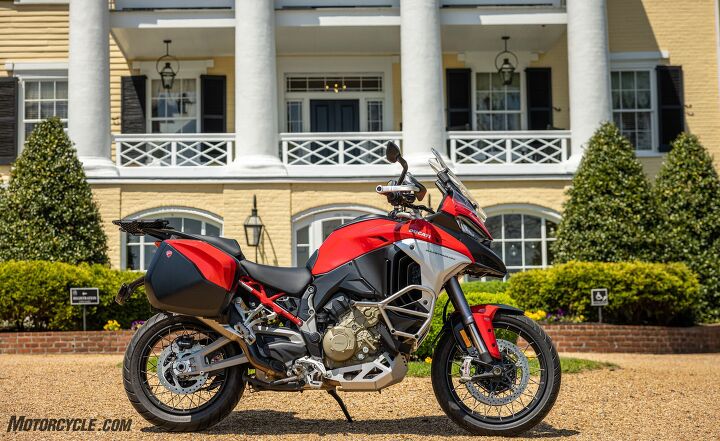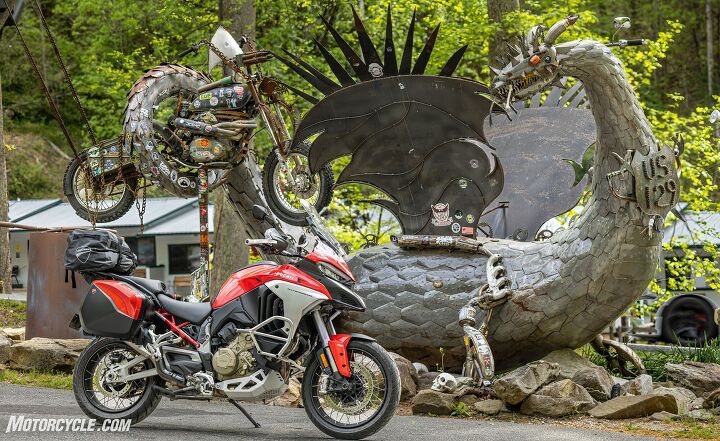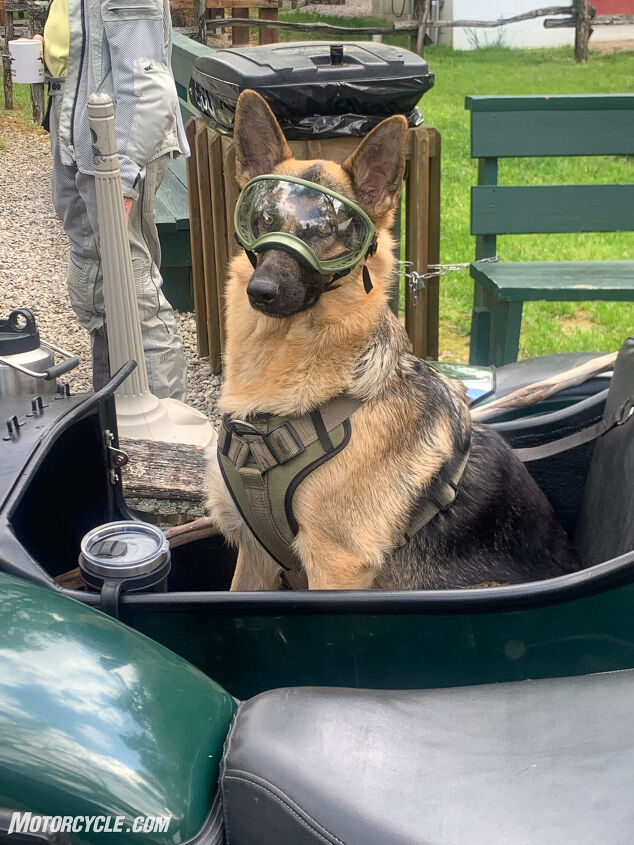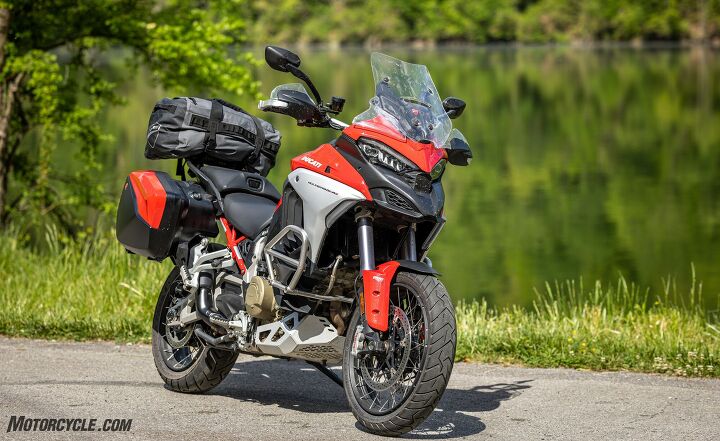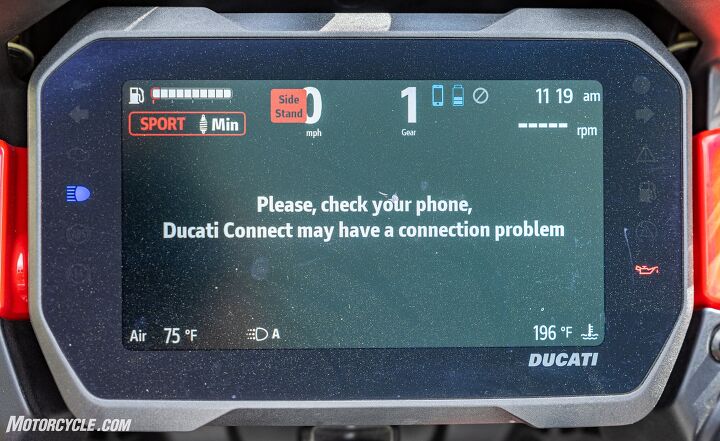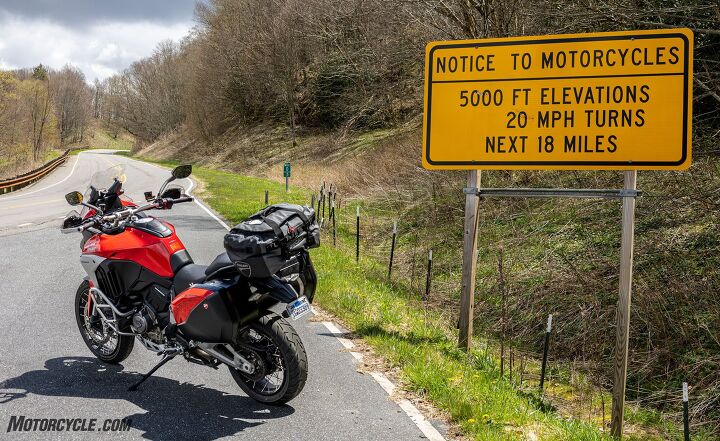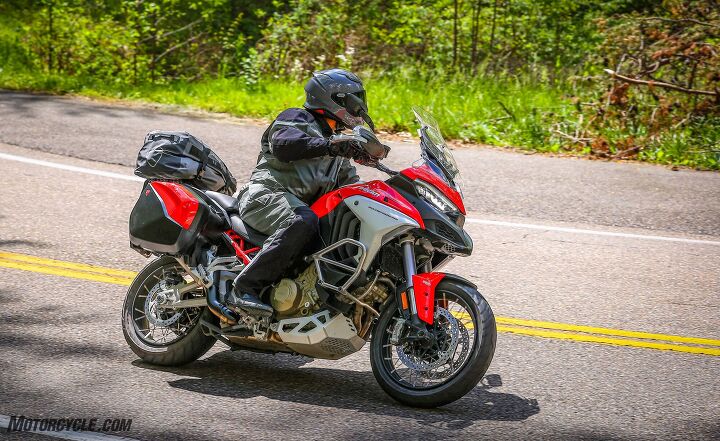Motorsports Racing News & Blog Articles
MO Touring: 2021 Ducati Multistrada V4S
Although I was born and raised in Virginia and North Carolina, I’ve done relatively little riding in the two states. When I got my first motorcycle license, I literally packed my belongings on my bike and set out for California the next day for a three-month, 11,000-mile tour. So, when I received the invitation to my 40th high school reunion (OK, 41st. Thanks, Covid.), thoughts of spending some quality, two-wheeled time in the mountains of my home states immediately came to mind.
After reaching out to Ducati, I was informed that I could pick up a 2021 Ducati Multistrada V4S in Charlotte, NC. Although the bike was a 2021 model, it has been upgraded with the 2022 firmware for the smartphone-powered infotainment system and now features a new, button-operated suspension lowering mode among other changes. Since Ryan has already written an in-depth review of the Multistrada V4, you should read that article first if you’re unfamiliar with all of the bike’s technical details or you want to know how the V4 did in the dirt. As I envisioned this tour, I figured that five days would give me ample time to see how the big Ducati would behave on your typical sport tour. In retrospect, maybe I should have set aside seven. Or ten.
2021 Ducati Multistrada V4SEditor Score: 94%
| Engine | 19/20 | Suspension | 14/15 | Transmission | 9.5/10 |
| Brakes | 9.75/10 | Instruments | 4.5/5 | Ergonomics | 9.5/10 |
| Appearance | 9.75/10 | Desirability | 9.25/10 | Value | 8.75/10 |
| + Highs Seamless, thrilling power Top-shelf braking Versatile suspension with convenient minimum preload feature | – Sighs Smartphone navigation integration needs improvement The phone storage needs better vibration damping or you may bork your iPhone’s camera Despite the excellent brakes, engine, and suspension, you never forget that you’re on a big, heavy motorcycle |
Setting the stage
My first full day with the Multistrada was destination focused. After a brief visit the night before with family and friends, I needed to get from Charlotte, NC to Richmond, VA as efficiently as possible, meaning it would be a 320-mile freeway slog. That’s fine. Whether or not you think the Multistrada’s prefix should be adventure or sport, it has tourer in its classification, and this day would be a great way to test its freeway mettle.
For my ride, the Multistrada was loaded with gear for the dual purposes of this trip. First, there was the reunion, which for some horrific reason was business casual and required me to travel with a suit coat, dress shoes, and all the necessary clothing that I got into the motorcycle industry to avoid. Then there was the sport tour through the mountains. For this, I traveled light with the exception of camera gear, which took up the entire left saddlebag. My true business clothes (t-shirts, jeans, undies, toiletries, etc) took up the right saddlebag.
By now, you may have noticed that I chose Ducati’s soft accessory tail bag instead of the hard trunk. I did this for two reasons. First, I’m not so fond of the looks of the hard bag and feel it messes with the proportions of the motorcycle. Second, I firmly (and wrongly) believed that my reunion-wear wouldn’t take up much room, allowing me to cinch the bag down tight and small. Well, by the time the bike was loaded, the tail bag was mostly full. Getting it on and off the Multi’s rack was as simple as clipping/unclipping the four attachment points. The bag even had a handle for carrying its bulk into hotel rooms.
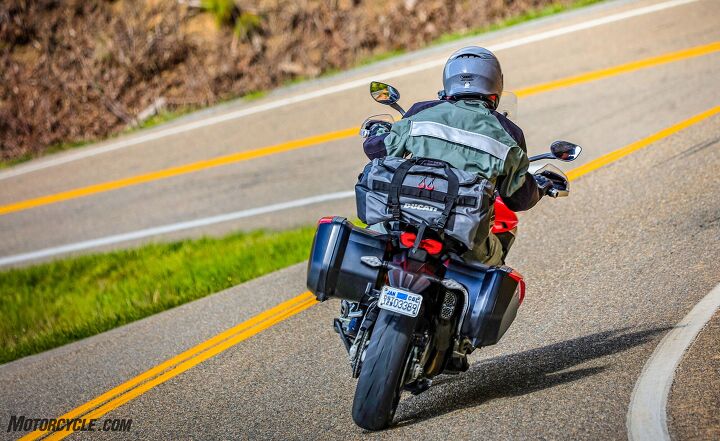
The Ducati accessory tail bag offers 30 liters of storage, and unlike the 48-liter top case, it packs smaller the less gear you carry. Image by killboy.com
Setting up the Multistrada for the interstate highway was simple for anyone who knows their way around the Ducati menu system. If not, five minutes is about all it would take to figure it out. I set the suspension to Rider+Luggage, put the ride mode into Touring, and let the ECU and Skyhook take care of the particulars. Of course, if I was unhappy with anything, I could set up my own values in the custom menu.
Getting my iPhone paired to the V4S was as simple as with almost any other Bluetooth device. I put both the bike and the phone in pairing mode and introduced them to each other. Establishing the WiFi connection took just a little longer with a couple taps of the screen required – a task I would become quite familiar with on the ride.
Aside from the updated infotainment system, the biggest change offered by the Multistrada V4S is the Ducati version of Adaptive Ride Height. The suspension button on the left grip has a cool new feature, which lowers the bike to minimum preload after a long press of the button. You may wonder why it isn’t automatic as on the Harley-Davidson Pan America. I did, too. So, at the Low Rider ST introduction, I checked out a hunch with the Harley rep, and yes, HD owns the patent on the software required to make the automatic lowering/raising of the suspension possible, requiring Ducati to either come up with its own way of implementing the feature or to pay a licensing fee (I assume).
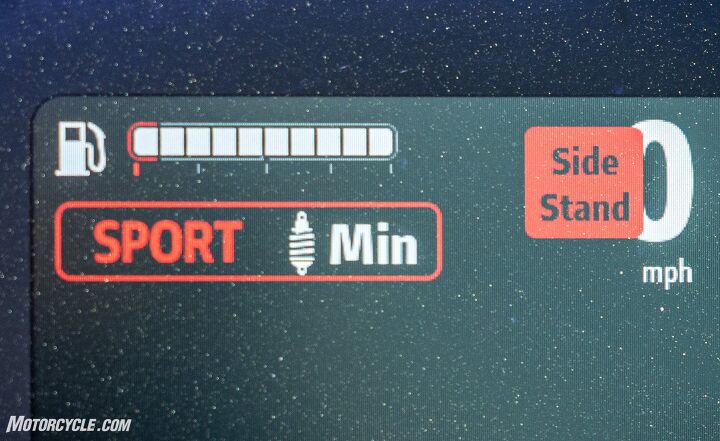
Shorter riders rejoice! Your reach to the ground can be minimized with the press of a button, and then you can keep it there for around town use.
Using the Minimum Suspension function is as simple as holding down the button until the suspension icon on the TFT starts to flash. The Multistrada takes care of the rest by reducing the shock’s preload completely. The suspension will stay in the low position until you tell it otherwise by long-pressing the button again. Here’s the trick, though. You don’t need to do this at every stop. The low suspension can be used up to 70 mph, allowing shorter riders (or even lazy ones, like myself) to set the suspension for the urban grind and then raise it up for the open road. You can do this at any speed up to 70 mph, too. Clever.
Since my first day was a point-to-point ride, I set it up that way in the Sygic app that Ducati requires for use with the Ducati Connect system. If you want to stop at multiple waypoints using the app, the trick is to choose the destination before adding the intermediate waypoints. Once I hit start directions, the Multi and I were on the road.
I started the trip at the end of the morning commuter congestion. The quickshifter makes light work of the up and down speed adjustments, while the bike’s nice balance keeps things simple when changing lanes to work my way through the traffic. (Oh, how I missed California’s lane sharing while on the East Coast.) The blind spot detection is worth its weight in gold in this type of riding situation. Like a quickshifter, it isn’t necessary, as I can easily turn my head, but once you’ve experienced the warning when someone has beaten you to the jump into the next lane, you probably won’t go back to riding a big bike without it. At night, I found the lights on the mirrors distractingly bright, but I also found the brightness setting in the system controls and set it to medium. My final note about the blind spot warning is that when a vehicle is approaching or already in your blind spot, the light comes on solidly. However, if you hit your turn signal for that side, it flashes feverishly, telling you that it would be wise to wait a moment.
Adaptive cruise control
Once the traffic cleared, I settled in for a good, long sample of the Adaptive Cruise Control. Another convenience feature that I don’t know how I lived without on my multiple cross-country trips (or from LA to Prudhoe Bay, AK) in the past. You can be sure that, when it comes time to hang up my keyboard and tour on my own bike with no story due afterwards, I will buy a motorcycle with adaptive cruise.
Ducati’s system feels more sorted than the system I sampled on the BMW R18B, which is really saying something. Every trick I threw at it to try to confuse the sensor for which vehicle was in which lane the system passed with flying colors. When a car jumped in front of me as I was approaching a truck to pass, I discovered that the cruise control has the ability to apply a degree of braking force. According to the owner’s manual, it is not capable of panic-stop maximum braking, but it did intervene for the fraction of a second it took me to apply the brakes.
Since the temperature was in the low 50s at the beginning of the trip, I got to sample the new heated grip function, which is completely operated by the button on the right grip. The heated seat still requires a trip to the menus via the joystick, but that’s no biggie.
Wind protection from the easily-adjustable windshield is great. In the high position, my 5-foot 11-inch frame sat in a comfortable pocket of air during the chilly morning. When in the lower position, the increased, cooling airflow came at the cost of a bit of slight buffeting around my helmet. It really wasn’t a big deal, and the cooling air through my helmet vents when the temperature climbed into the 80s was worth having to turn up the volume on my Cardo slightly.
From A to C via BBQ
Since I live on the other side of the country, I don’t get to the state of my birth very often. When I do, there are a couple of places that I make sure I visit after spending some time with my immediate family. One of those places is King’s Famous Barbecue in Petersburg, VA. My ties to the restaurant go beyond the fact that it’s the best barbecue I’ve ever eaten (King’s is the recipient of an award from Virginia Tourism as Top Three BBQ Restaurants in Virginia and Best Barbecue Sauce in the South in Southern Living Magazine, among others). I have many memories of going to King’s in my Sunday best after church with my grandparents from the time I was a small child until my early teens. I usually order the same thing: a sliced pork shoulder sandwich plate with green beans and coleslaw (sometimes with onion rings) and a peculiarity I picked up from my grandfather: hot, homemade apple pie with a slice of butter on top. Then on my way out of town, I always stop by the cemetery where my four grandparents rest to pay my respects for the integral role they played in my childhood and tell them how my life is going.
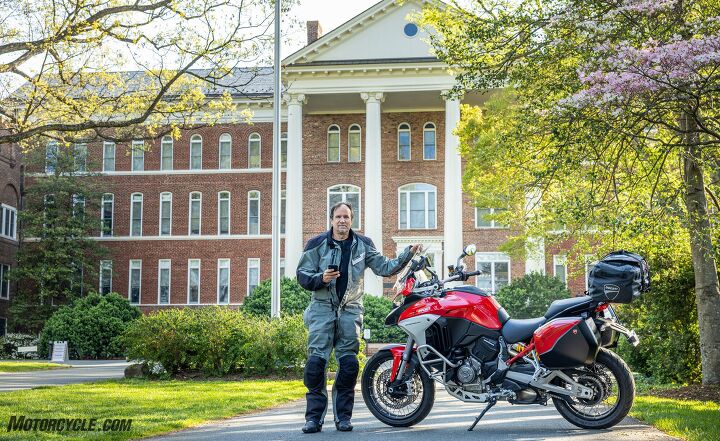
Here I am, now officially a member of the Woodberry Forest School “Old Guard,” preparing to leave after a fun-filled weekend of visiting with friends, some of whom I hadn’t seen since graduation.
Into the mountains
After two days of reminiscing with old friends at my alma mater, it was time to don my Aerostich and get ready for some serious riding. Unfortunately, I had to slog through 270 miles of interstate to reach the fun stuff. I was out to slay a dragon, and not the dragon that most motorcyclists are familiar with, either. My destination was the Back of the Dragon starting in Tazewell, VA.
I love maps, and I spent the weeks leading up to this trip poring over websites and a variety of maps to plot my route through the Blue Ridge Mountains on my way to Asheville, NC for a night. My workflow was to find a road online or on a map, look for it in Apple Maps, find an address on the road that I wanted to use as a waypoint, and copy the address into the web interface on the Sygic website. Why the convoluted technique? Well, the Sygic website is not terribly flexible, and I occasionally had to use multiple waypoints to force the algorithms plotting the route to follow the roads I wanted. Sygic always wanted the most efficient path, which was at odds with my goals. (A side note: Be careful with errant clicks on the Sygic website. One night, I accidentally deleted several hours worth of work with a misplaced finger on my iPad.)
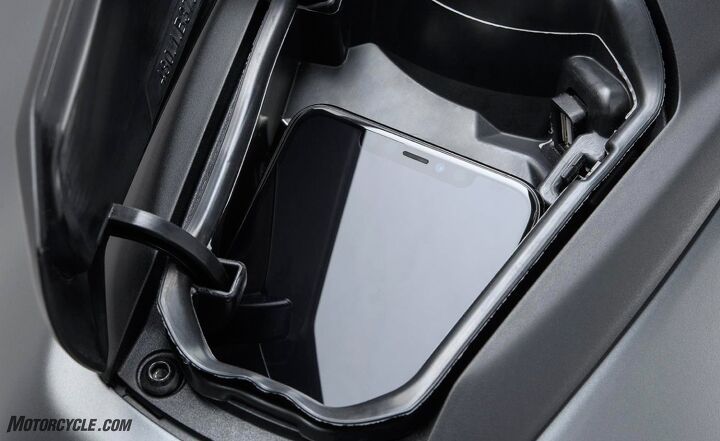
The Multistrada V4S offers a convenient, powered, and waterproof phone storage locker behind the gas tank filler. I’ve read online about some riders having their phones overheat during summer rides. Also, I’d recommend wrapping your iPhone in some kind of soft foam padding. About halfway through the trip, my camera developed the dreaded lens jiggle that signals a failed or failing image stabilization. Consequently, I can no longer take sharp photos in low light, but full daylight, with its associated high shutter speed, is fine.
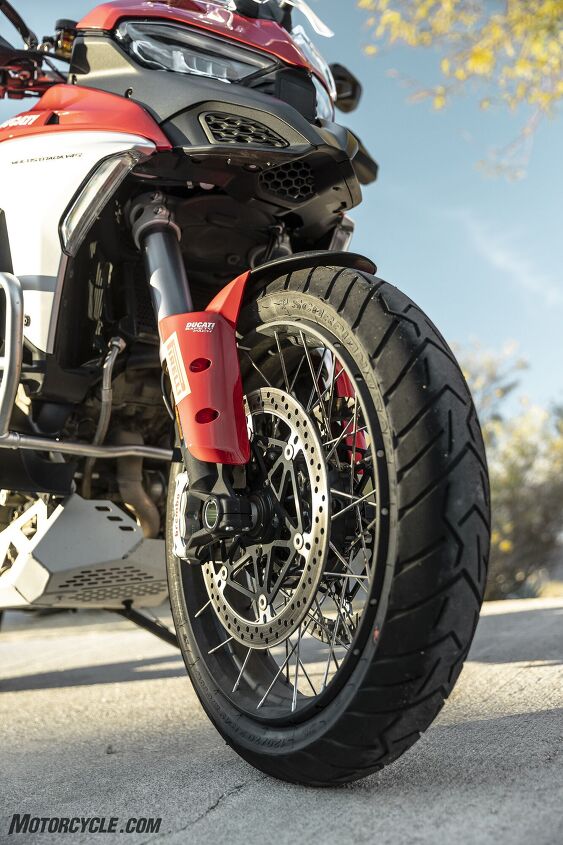
The Pirelli Scorpion Trail tires proved to be remarkably sporty, never putting a step out of place in 1,400 miles. Still, I couldn’t help pondering what the Multistrada would be like in the Pikes Peak setup with 17-inch wheels and sticky rubber.
Once the complete route was stored on the website, in order to get the waypoints onto my iPhone, I had to click a Send to GPS link, enter my email address, and click the link in the email to open and load the route in the app when I was ready to ride. While I admit that I may be a bit of an edge case when it comes to plotting routes, this method of implementing directions is untenable. Hopefully, it will be rectified in future updates of the app. However, even on simpler point-to-point routes, I frequently found that the Sygic app didn’t have a listing for the business/hotel I was looking for, forcing me to look up the address on Apple Maps, copy the address, and paste the results into Sygic.
My ride had one range-anxiety moment. In a remote section of western Virginia, I noticed that the fuel gauge had flipped over to low fuel mode, and it was counting down the miles to empty. By the time I was able to find a gas station, it had been claiming zero miles of fuel left for over 10 miles. After pumping just 5.1 gallons into the 5.8 gallon tank, I was educated in the gauge’s pessimism and didn’t worry about range for the rest of the trip. Later, a calculation of the 37.1 average mpg times the tank’s capacity yielded a 215 mile theoretical range.
Perhaps, most Virginia riders are aware of the Back of the Dragon, but while it claims to pack a mere 300 corners into 30 miles, sections of the route were even tighter, gnarlier, and narrower than the more famous Dragon appendage in Tennessee.
The Multistrada’s V4 Granturismo engine acquainted itself to the transition from rural two-lane highways to the serpentine pavement. Although it frequently wasn’t necessary for the medium-speed corners, the quickshifter smoothly worked through both up and downshifts as the corners required. The Back of the Dragon got so tight at some points that first gear was required, and even the tricky downshift from second while leaned over in a curve was handled without upsetting the chassis. The only place the fueling wasn’t spot on was in the extreme lower rpm where the transition from off- to on-throttle was a little abrupt. This is really just picking nits, but it serves to highlight how smooth the rest of the throttle inputs were – even with the ride mode set to Sport.
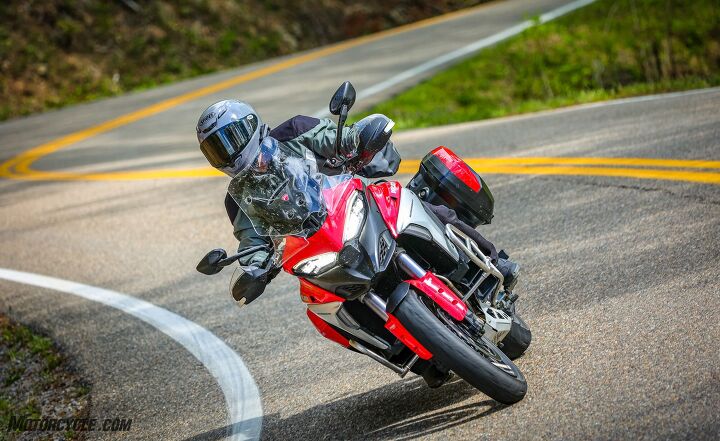
The Multistrada’s wide bars offered plenty of leverage for muscling the bike through the pair of Dragons I encountered. Image by killboy.com
The standard Sport suspension settings felt quite good for hustling a big bike, loaded with gear, through the mountains. Leaned over, the suspenders soaked up all manner of road imperfections – even one pothole hidden in the shadows – without unsettling the chassis. Still, a long-travel suspension (6.7 in. and 7.1 in. front and rear) will tend to pitch if you’re abrupt with any inputs. The two places I noticed this the most was in quick side-to-side transitions under hard acceleration, where the front end lifted all the way to the stops and even lofted the front slightly (remember, this is wheelie-deficient me, so the rubber was likely only a quarter-inch from the tarmac). The fork rewards smooth application of the brakes which brings the inverted sliders down into the meat of their stroke. Get ham-fisted with the front brake, and the chassis will dive forward rather abruptly. (Of course you can totally go in there and firm or soften the standard Sport settings when you have the time.)
After surfing the Back of the Dragon, you might think that the rest of the day would be a letdown. You would, however, be quite wrong. My time in Virginia and crossing over into northern North Carolina was filled with a seemingly endless series of corners and spectacular views. My only regret is that due to a GPS issue, I missed out on Highway 221 south of Boone, NC, which had been recommended by a friend during my visit in Charlotte. Once I discovered my mistake, it was too late in the day to retrace my path. I had to pop onto the Blue Ridge Parkway (which I had been scrupulously avoiding because when you get caught speeding there, you’re dealing with the Feds) to get some photos in the late light.
At the end of 440 fun-filled miles, I rolled into Asheville well after dark.
Trading the Blue Ridge Mountains for the Smokies
Even though I was in the Blue Ridge Mountains when I woke up, my plan was to spend a big chunk of the day in the Great Smoky Mountains along the North Carolina/Tennessee border. The expected peak of the ride was a blast down The Tail of the Dragon with its 318 corners in just 11 miles. Consequently, my morning began with another interstate highway jaunt to get from where I was to where I wanted to be. By now, I was quite comfortable with the V4S’ ability to devour the miles and settled in to enjoy the scenery.
The closer I got to Deal’s Gap, the better the roads got, but before I took on the Dragon, I stopped at the cafe there to sit back with a cup of coffee and enjoy the scenery. The Monday morning crowd’s age skewed slightly older than my 60 years and leaned towards cruiser-style motorcycles, but there were still some members of the below 40 set, including a dude in full leathers railing on a tricked out Grom. The thing that really caught my attention was the pair of Urals with a total of three dogs in their two sidecars.
With a full gas tank and a cup of coffee in my belly, I set out for my third visit to the Dragon, and it is the same as it ever was. Exquisite. Challenging. Life affirming. A regular old kick in the pants! Those superlatives also apply to the Multistrada’s behavior on the Dragon.
On the Tennessee side of the Dragon, I pulled over by a lake to take some pictures for this article and was greeted by the aforementioned three dogs, which led to a lengthy roadside conversation about all things motorcycles with the two Ural riders and their Roadmaster-mounted friend.
Navigation app issues
Although I was heading west, things went south almost immediately after I got back on the road. The Sygic app issues which had plagued me off and on throughout the trip became almost terminal. The app wanted to send me back to previous waypoints. So, I stopped, turned off the bike (which is required to get the app out of its faceless mode and edit my waypoints), and started deleting the prior waypoints one at a time. After about 20 minutes, I was able to get back on the road again, only to have the app start crashing and freezing on the Multistrada’s TFT. This time, I had to restart my iPhone twice, delete the GPS track I was following, redownload it over the world’s slowest cellular connection, delete the previous waypoints again, and finally get back on the road.
And now a word about my disdain for motorcycle manufacturers that try to reinvent the wheel when Apple CarPlay and Android Auto offer what is, in my experience, a more stable smartphone/vehicle integration. One of the new features that Ducati wanted me to test was the infotainment system’s ability to stay connected to the phone for up to 20 minutes at, say, a fuel stop. (And it works quite well.) The reason for this update is that it takes, on average, one-minute ten-seconds for the Multistrada to connect to the phone and start showing the map. (I timed it. Several times.) The necessary Bluetooth connection takes from 30-45 seconds, and then the bike and phone need to connect via WiFi because Bluetooth doesn’t have the bandwidth to support the navigation features. Finally, sometimes the WiFi connection doesn’t automatically take place, requiring the user to go through the process of reselecting the bike’s WiFi network.
Remember, if you need to access the Sygic app for any reason, you have to shut down the bike or use the joystick to enter data when setting a destination. As far as I could tell, there is no way to delete or skip waypoints via the joystick/TFT interface when a route is actually loaded. So, I went through the shutdown, change the waypoints, and restart the system dance many times before I could get back on my route. In my opinion, this level of kludginess is unacceptable on a motorcycle costing $28,000. I felt the same way about BMW’s proprietary app on my ride from Denver to LA on the R18B. It’s sad that on bikes which have such beautiful TFT displays that it might make more sense for an end user to bolt a GPS to their bike’s handlebar. But then again, maybe I’m more than just an edge case in the level of control I want in planning my routes over particular roads.
The payoff
The thing that kept me from getting a case of the fuckits and simply entering the address of my hotel in Charlotte and riding the 270 miles back – over the Tail of the Dragon and the other roads that I had enjoyed so much earlier in the day – was that after poring over maps when planning my route, I had an inkling that Highway 165, otherwise known as the Cherohala Skyway, out of Tellico Plains, TN was going to be something special that I shouldn’t miss.
And I was right.
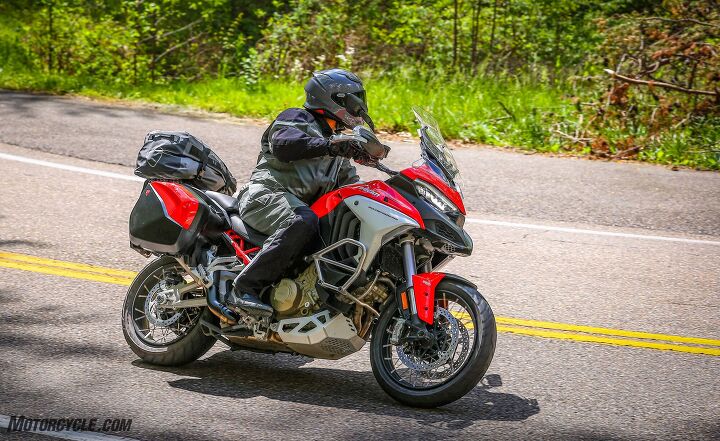
Setting your throttle and suspension modes up for weather touring or attacking a set of twisties is as easy as pressing a button. Image by killboy.com
Although I was still over 200 miles from my destination at the end of the Skyway in Robbinsville, NC, the trip culminated there. I’ve ridden some special roads in my life, but this one is one of the best. The pavement was mostly pristine, with corners that vary from tight and twisty to massive sweepers going from 180° to as much as 270° with a tightening radius at the end just to keep things interesting. In the morning, I’d set my goal for the day to work on the lighter, longer braking technique emphasized in the Yamaha Champions Riding School (read here, here, and here), and the Ducati Multistrada V4S proved, once again, to be a willing and capable dance partner that allowed me to up my game on this ribbon of moto-nirvana to the point that I was almost in a meditative state. However, I have to warn you that the speed limit is quite low in places, meaning that if you’re having fun it will very likely result in a huge ticket if you encounter The Law, so stay sharp.
Parting thoughts
When I dropped off the bike at Motorcycles of Charlotte, I reluctantly handed over the key fob. Despite my extended rant about navigation woes (most of which could likely be addressed with an app update), my time with the Ducati Multistrada V4S was exceptionally good. I logged 1,400 miles in what was essentially three days of riding. All of the changes that Ducati made on the bike to bring it up to 2022 model year spec were well implemented, particularly the Minimum Preload function that will be a boon to those who have shorter inseams.
While I rode this adventure touring bike on nothing but pavement, it’s not surprising to see how the sport-touring market has morphed to include this style of motorcycle. The riding position is all-day comfortable yet still flexible enough to allow for me to get my ya yas out when the road called to me. If only the trip could have been a couple of days longer.
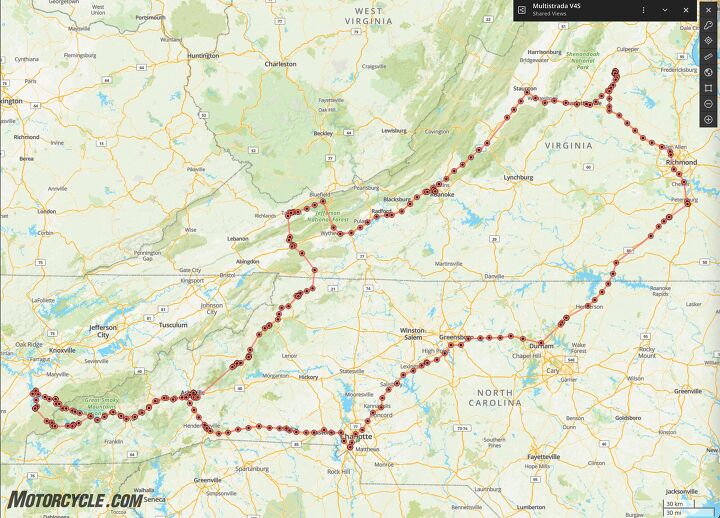
What 1,400 miles looks like. Unfortunately, my Spot Tracker missed an entire section of Tellico Plains and the Cherohala Skyway on the bottom left.
|
In Gear Helmet: Shoei RF-1400 |
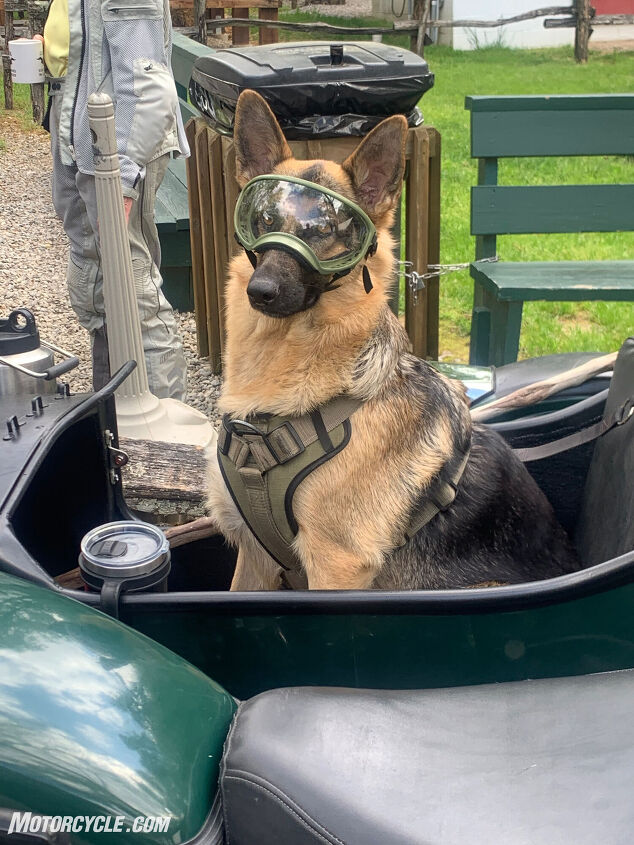
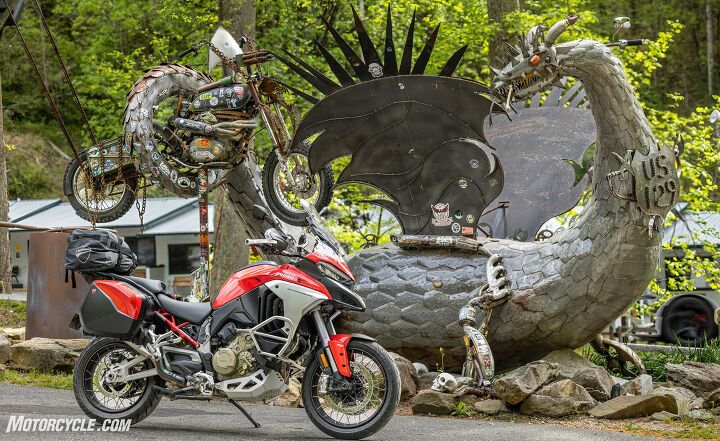
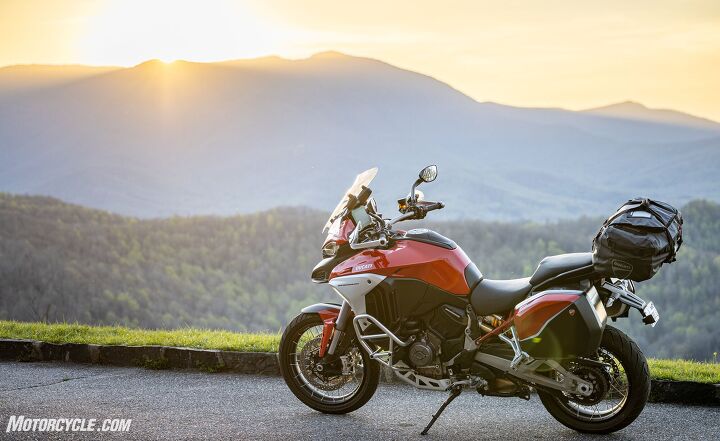
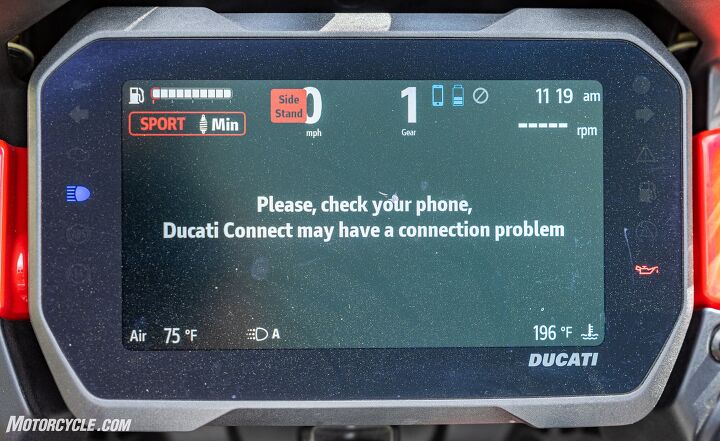
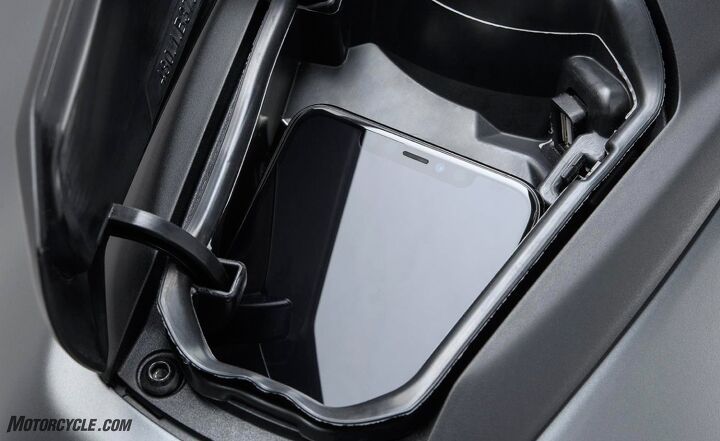
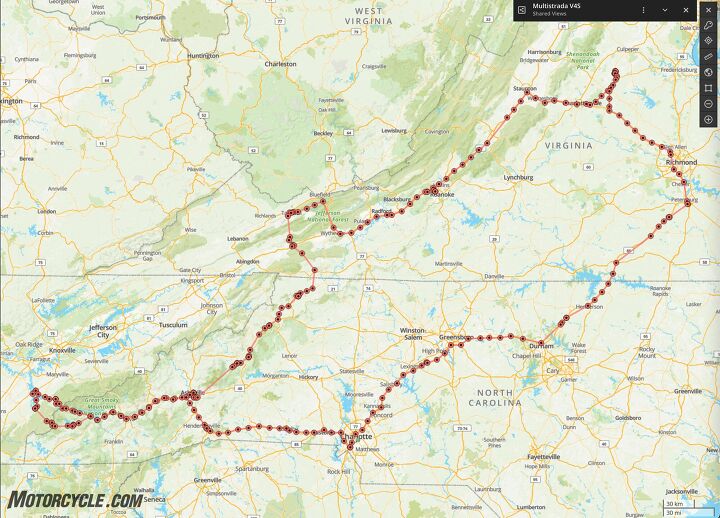
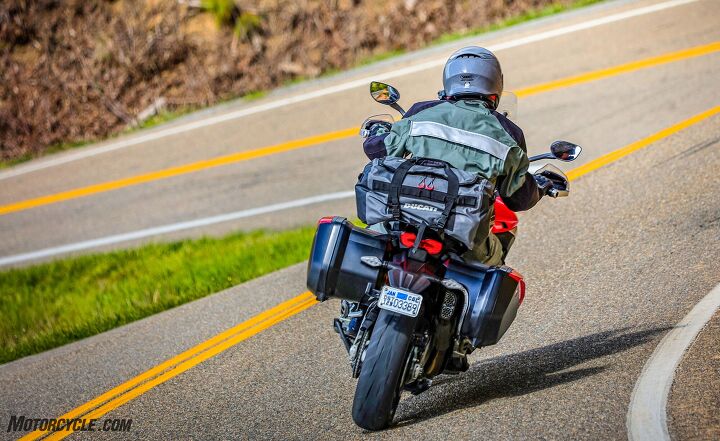
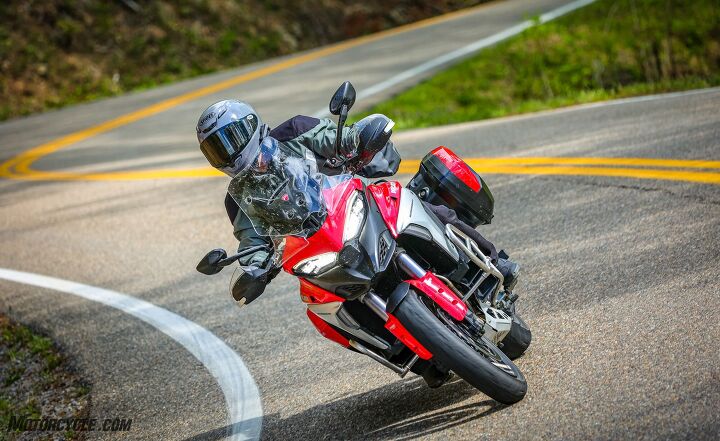
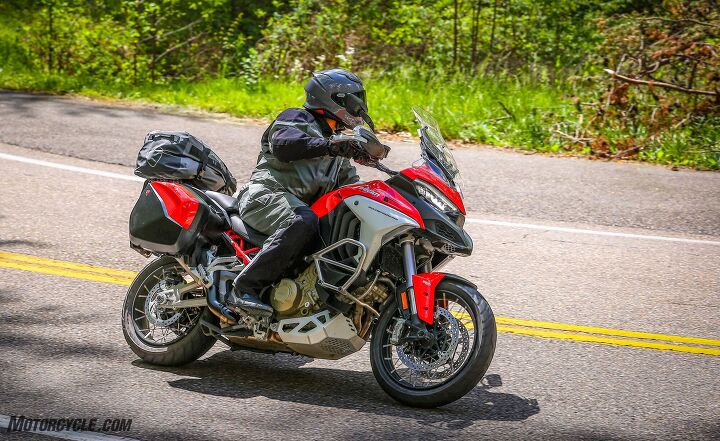
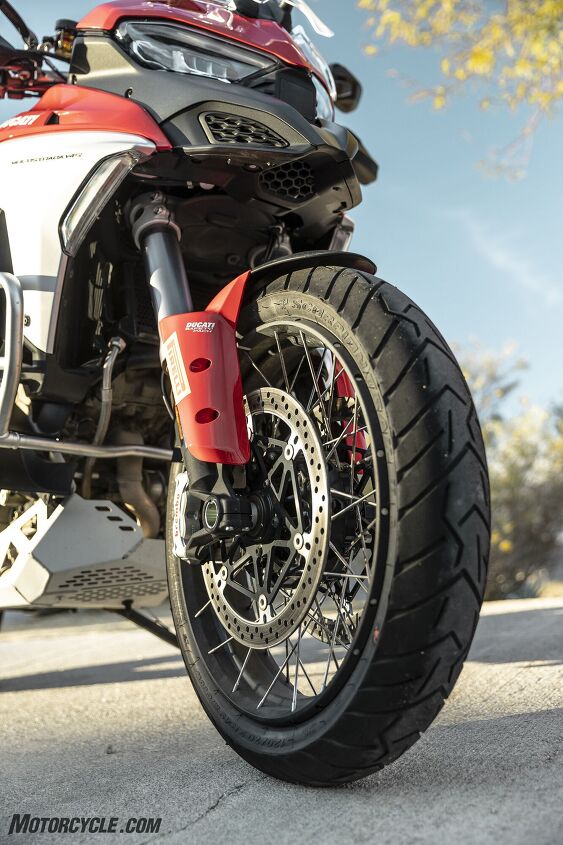
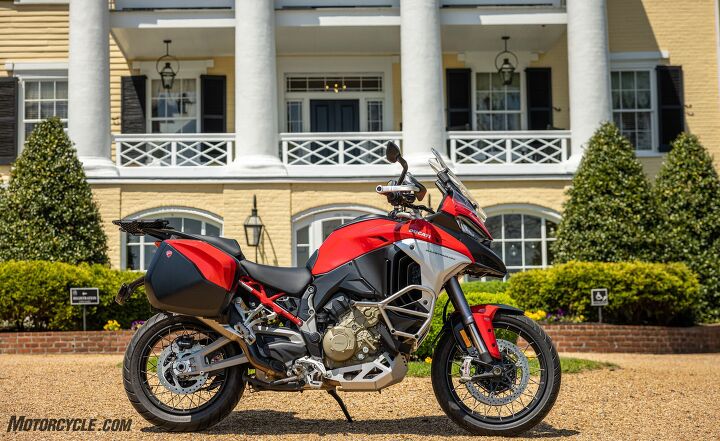
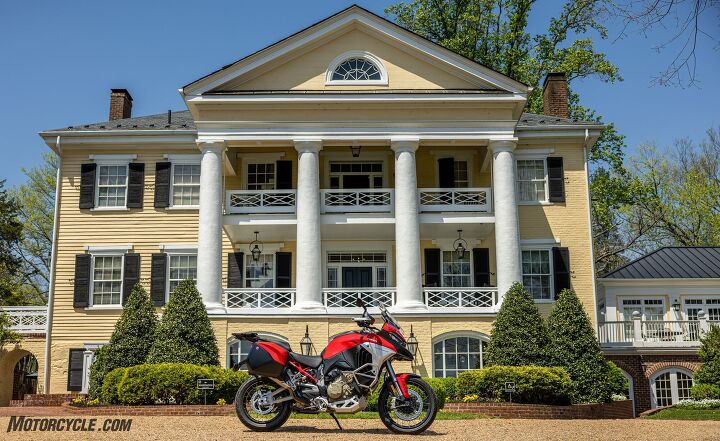
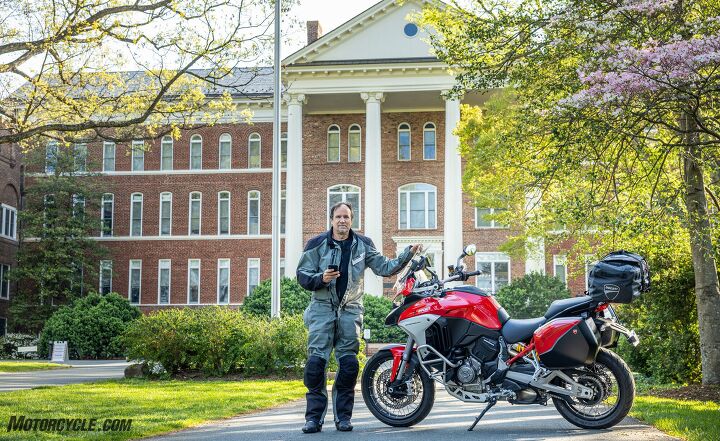
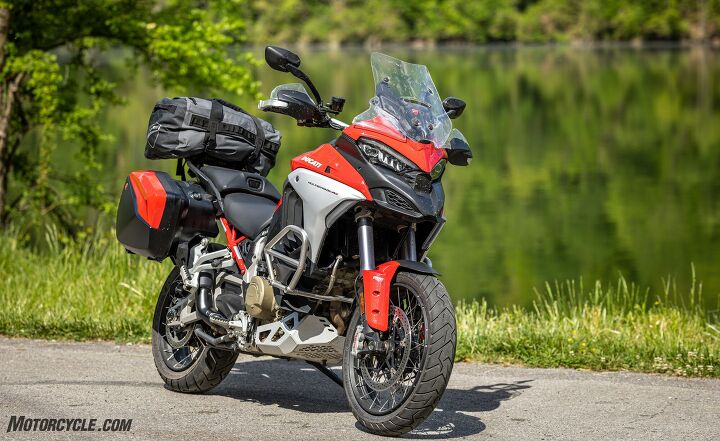
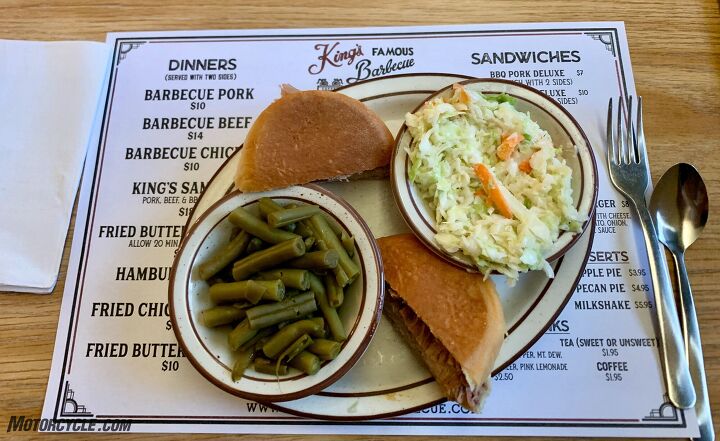
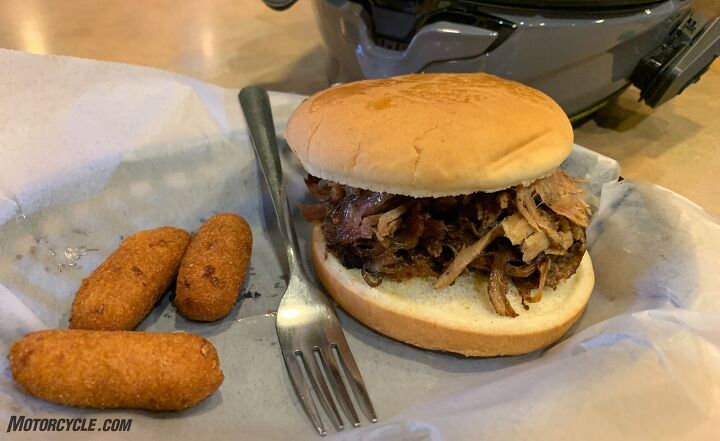
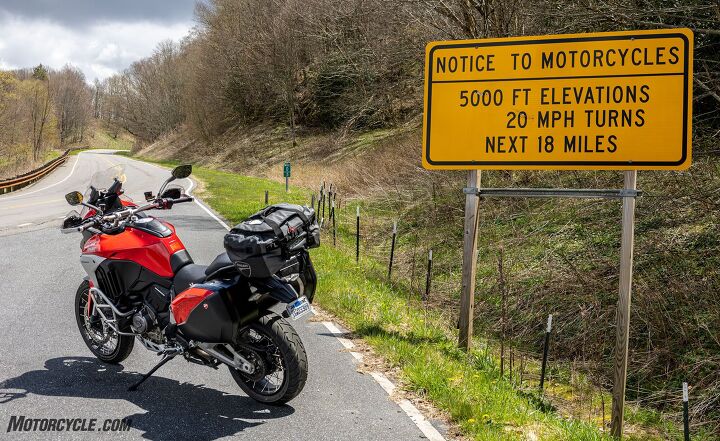
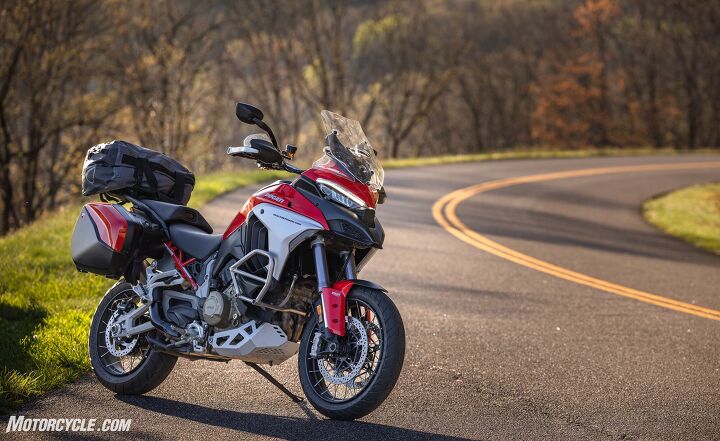
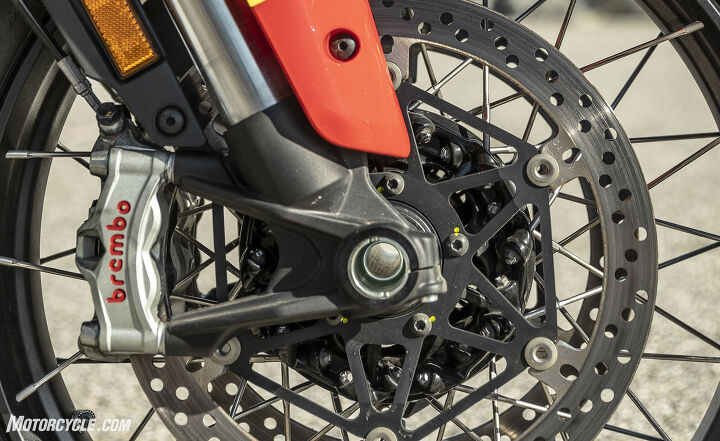
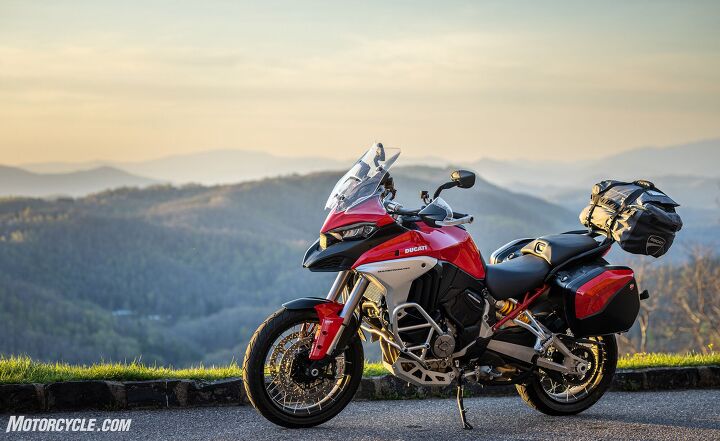
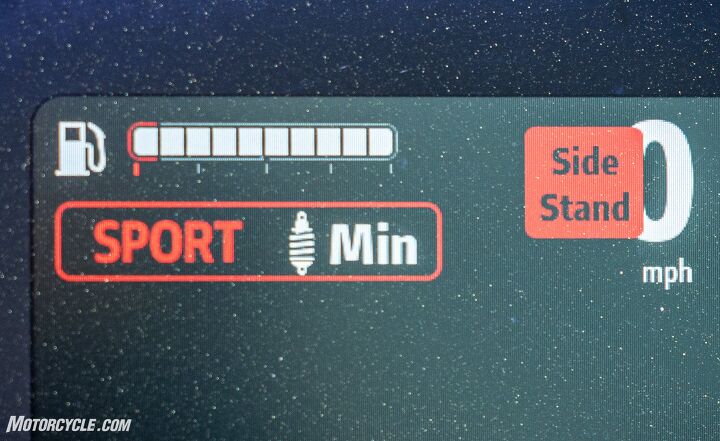
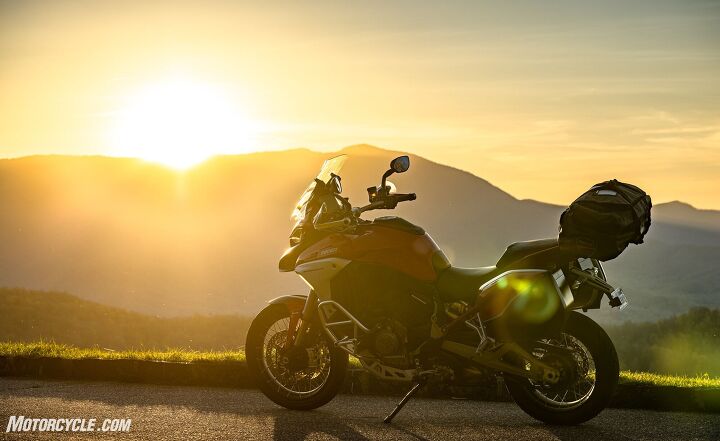
We are committed to finding, researching, and recommending the best products. We earn commissions from purchases you make using the retail links in our product reviews. Learn more about how this works.
Become a Motorcycle.com insider. Get the latest motorcycle news first by subscribing to our newsletter here.
The post MO Touring: 2021 Ducati Multistrada V4S appeared first on Motorcycle.com.
Copyright
© Motorcycle.com


